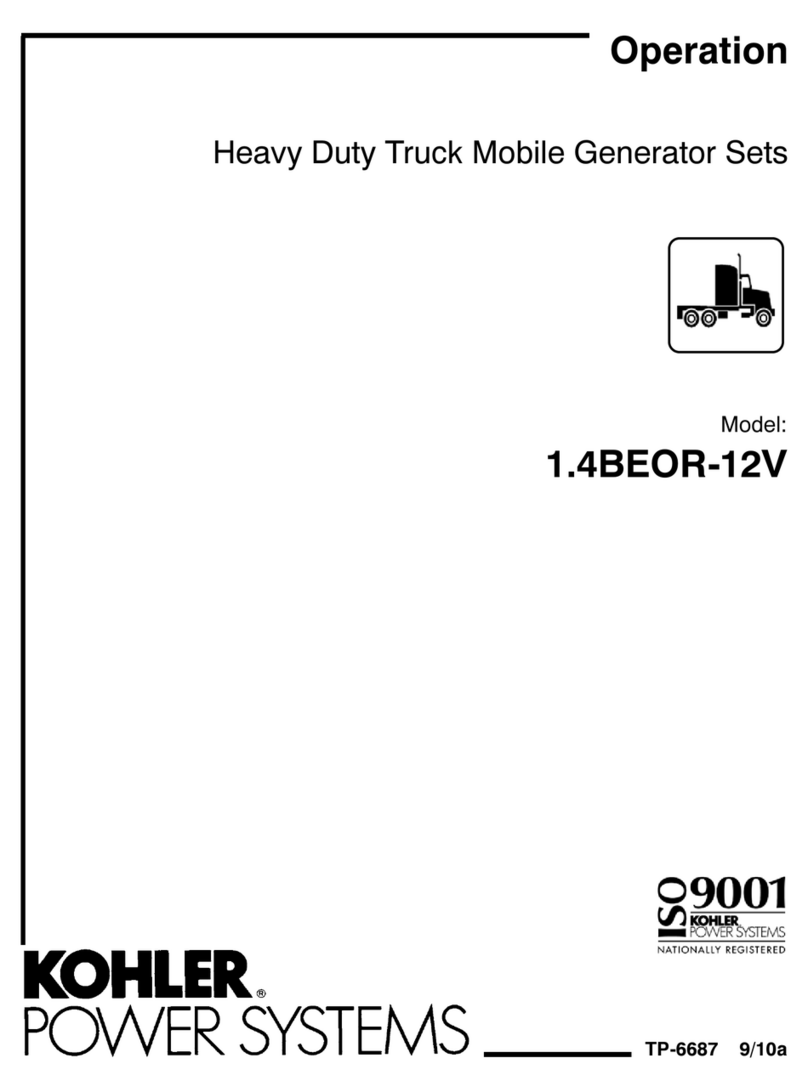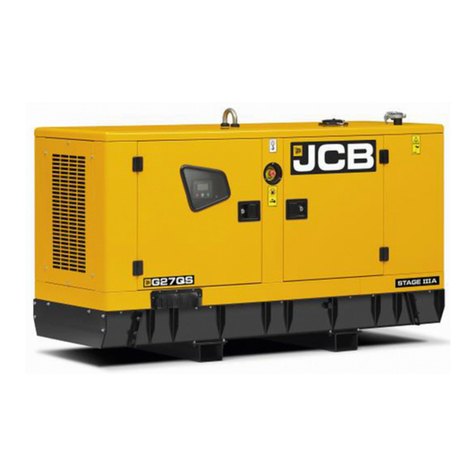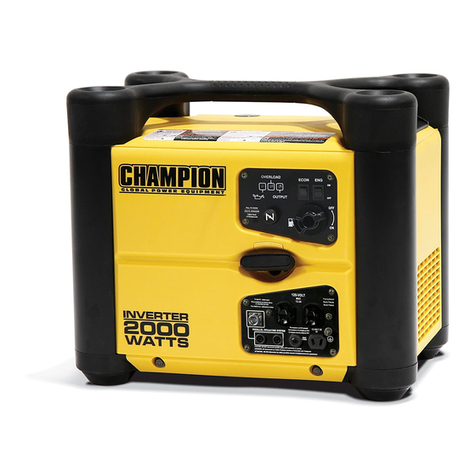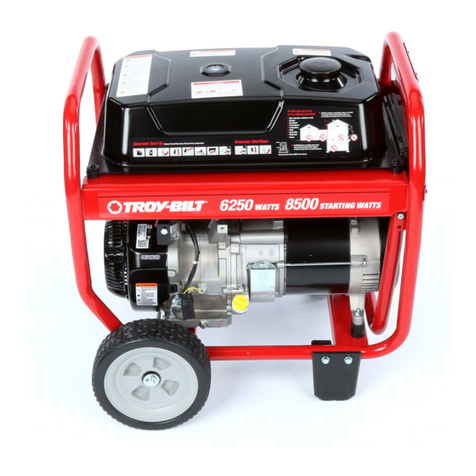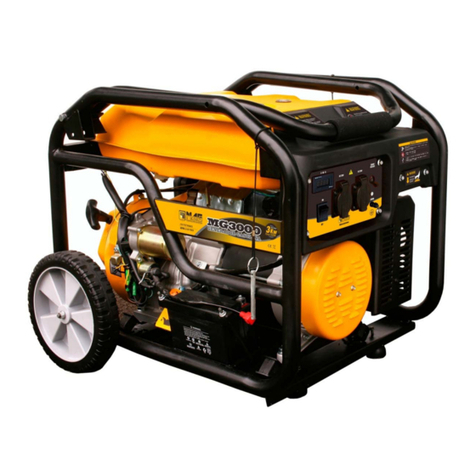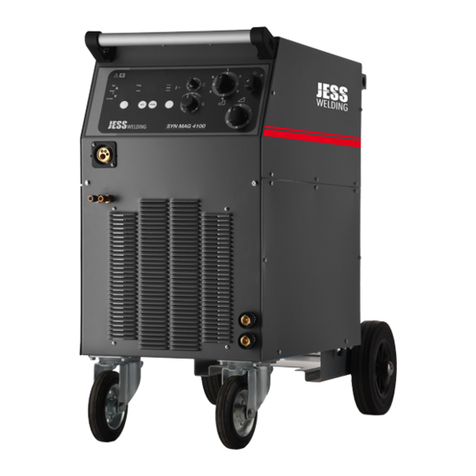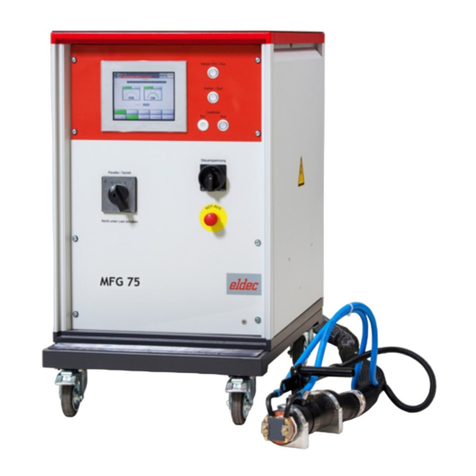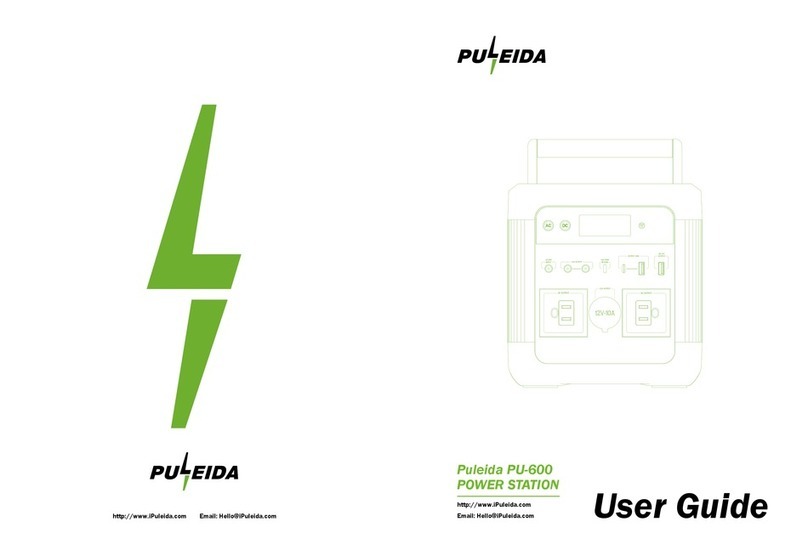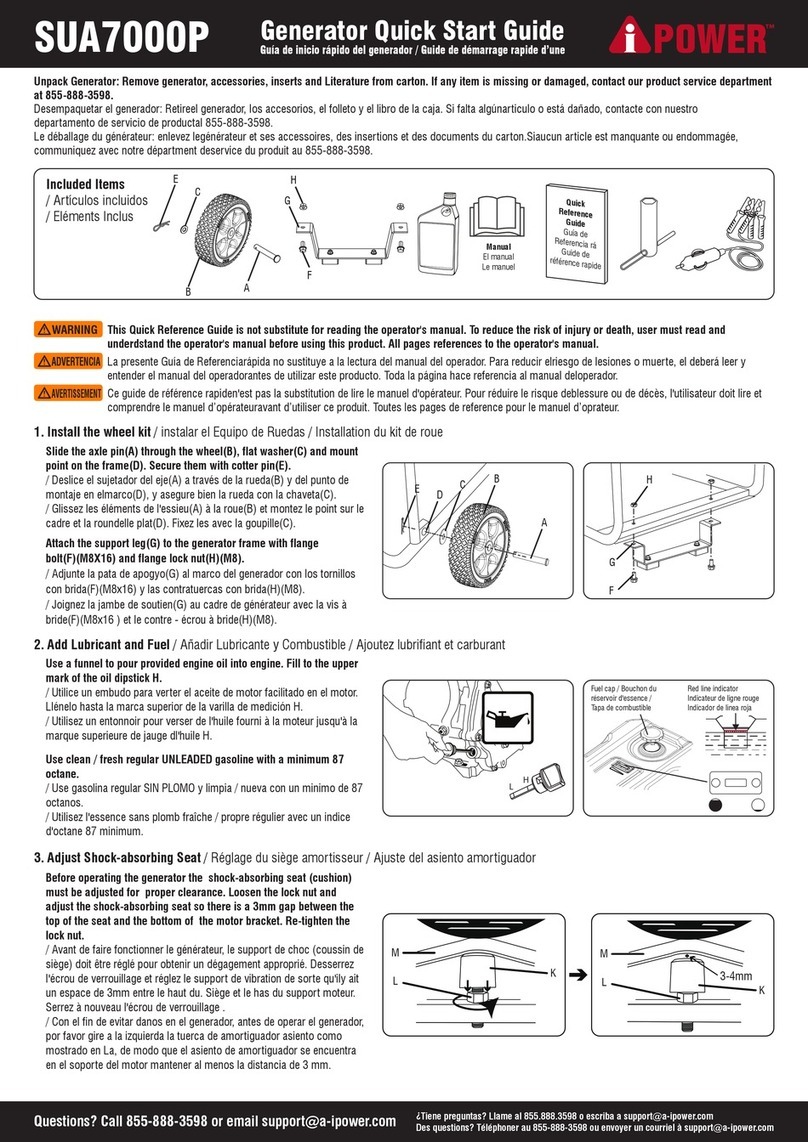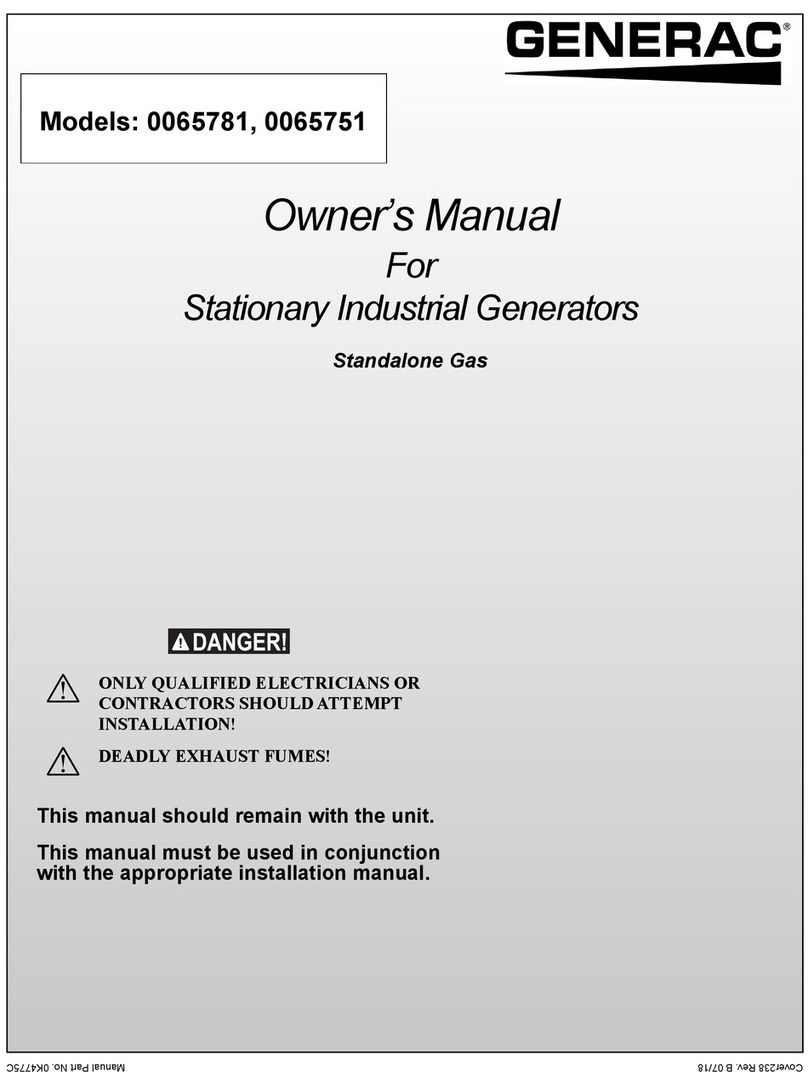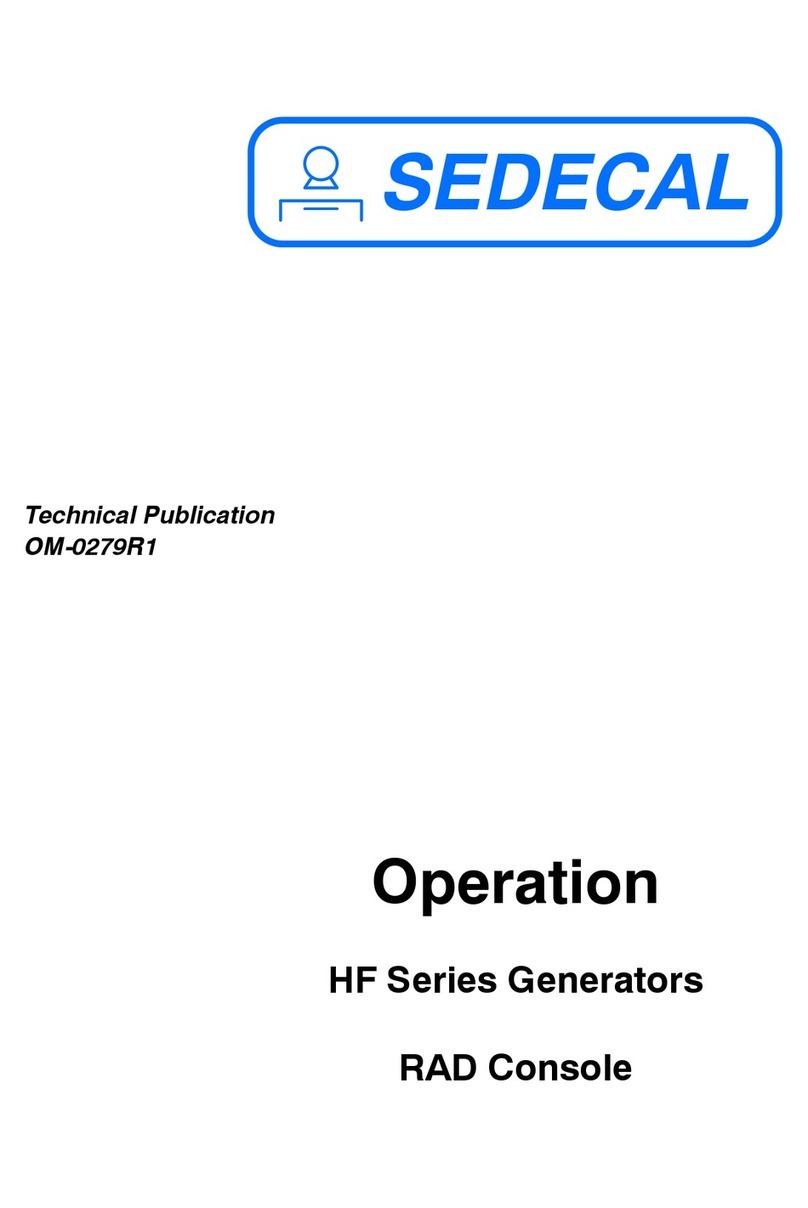Emax EGES14020T User manual

EGES14020T
3 IN 1
COMPRESSOR WELDER GENERATOR
Operating Instructions
EGES14020T man v.190417
EMAX designs and manufactures products for safe operation. However, operators and
maintenance persons are responsible for maintaining safety. All safety precautions are included
to provide a guideline for minimizing the possibility of accidents and property damage while
equipment is in operation. Keep these instructions for reference.

2
Gas Powered 3-in-1 Compressor /Generator/Welder
Table of Contents
Retain this information ………………………………… 2
Model Specifications …………………………………… 3
Functional Description ………………………………… 4
Safety Symbols …………………………………………… 9
Basic Guidelines ………………………………………… 9
California Proposition 65 Warnings ……………… 9
Read all instructions before using this tool … 9
Inspection …………………………………………………… 10
Lifting Safety ……………………………………………… 10
Gasoline Engine Safety ………………………………… 10
Positioning ………………………………………………… 10
Airflow ……………………………………………………… 11
Exhaust ……………………………………………………… 11
Compressor Safety ……………………………………… 12
Breathable Air …………………………………………… 12
Pressurized Components …………………………… 12
Personal Protective Equipment …………………… 12
Installation Area ………………………………………… 12
Piping………………………………………………………… 12
Safety Steps ……………………………………………… 12
Piping / Tank Installation …………………………… 12
Truck Installation ……………………………………… 13
Battery Component …………………………………… 13
Safety Steps ……………………………………………… 13
Generator Safety ………………………………………… 14
Welder Safety ……………………………………………… 15
Work area ………………………………………………… 15
Electrical Safety ………………………………………… 15
Personal safety ………………………………………… 15
Equipment Use and Safety…………………………… 16
Safety while Servicing ………………………………… 17
Wiring ……………………………………………………… 17
Specific Areas of Danger …………………………… 17
Electrical Shock ………………………………………… 17
Fumes and Gases ……………………………………… 18
Flash Hazards; UV and IR Arc Rays ……………… 19
Fire Hazards ……………………………………………… 19
Hot Materials……………………………………………… 20
Electromagnetic Fields ……………………………… 21
Sources of Welding Safety & Standards Info … 21
Unpacking…………………………………………………… 22
Lifting this equipment ………………………………… 22
Placement ………………………………………………… 22
Piping / Tank Installation …………………………… 23
Lubrication ………………………………………………… 23
Minimum Pipe Size for Compressed Air Lines 23
Battery Set-up and connections…………………… 24
Grounding ………………………………………………… 24
Operation …………………………………………………… 25
Safety Rules ……………………………………………… 25
Start-up ……………………………………………………… 25
Engine Throttle ………………………………………… 26
Engine Break-in ………………………………………… 27
Compressor Break-in ………………………………… 27
Welding ……………………………………………………… 27
Selecting the proper electrode …………………… 27
Maintenance ……………………………………………… 27
Safety Steps ……………………………………………… 27
Maintenance ……………………………………………… 28
Belt Adjustment ………………………………………… 28
Changing Compressor Oil …………………………… 28
Maintenance ……………………………………………… 29
Maintenance Procedures Rationale ……………… 29
Storage Of This Equipment: ………………………… 29
Troubleshooting Chart ………………………………… 30
Warranty …………………………………………………… 31
Retain this information and your original purchase receipt for
future reference
Record your machine's particulars here:
Serial Number:
Model Number:
Date of Purchase:

3
EGES14020T man v.190417
Operating Instructions
Model Specifications
EMAX Gas Powered 3-in-1 Compressor/ Welder/Generator
Power Type 4 stroke gasoline engine
Features • OHV
• Cast iron cylinder liner
• Aluminum block
- Low oil sentry: switch designed to prevent engine from starting
in a low oil or no oil condition.
Horsepower 14 HP 10 kW
Brand Kohler Command Pro
Compressor Conguration 2 stage
Features • Built in oil pump to give each pump bearing positive oil lubrication.
• Inner stage cooler and after cooler.
• Cast iron pump, head, cylinders, crankcase, connecting rods,
HP piston and ywheel
• Head unloaders- load-less start
• Oil sight glass
• Disc valves for durability and ease of maintenance
• Dual roller bearings
• Dual belt drive
• 100% rebuildable.
• 4 piston ring design for low 1 to 5 micron oil carry over.
Air production @
175 psi
16.8 scfm 475.72 l/min
Max. pressure 175 psi 1206.58 kPa
Air Reservoir Tanks 2 x 10 gal. 2 x
37.85 liters
Total 20 gal. 70.71 liters
Generator 120 volts AC 60 Hz. 20 amps
240 volts AC 60 Hz. 20 amps
12 volts DC 8.3 amps
Peak 5500 watts
Continuous 5000 watts
Duty cycle 80%
Welder DC welding power 190 amps
Duty cycle 80%
Welding cable 25 ft. 7.62 m
Ground cable 25 ft. 7.62 m
Total Features • Dual port tank air regulator with liquid lled tank/regulator gauges
and dual 1/4” quick disconnects.
• Dual no-at tires with grease ttings
• Removable wheels and handle allow for stationary or
for portable use.
• Rubber tank isolator pads
• Lifting hooks for lifting
• All steel belt guard
• Dual tank condensate drain valves
Weight 550 lb. 249.5 kg

4
Gas Powered 3-in-1 Compressor /Generator / Welder
A
B
C
E
Y
D
G
H I
J
K
L
M
N
O
F
Y
Z
g.1 Compressor/Welder/Generator:mainareas
Functional Description
The EGES14020T was designed as a mobile and stationary power source, providing power in the form of
either compressed air or electricity, to drive pneumatic and electrical equipment, or for welding metals. Its
base motive force is provided by an air-cooled 4 cycle 14 horsepower Kohler gasoline engine. In common
with most generators, the engine is regulated to respond to demand, powering up when needed to produce
electricity or air, and running at idle until needed again. As a compressor, it can provide an air volume of 16.8
scfm at 175 psi and with a 20 gallon reservoir. The generator produces 5000 continuous watts (5500 peak
watts) of AC electrical power. Its electrical output will enable 190 amp DC stick welding with an 80% duty
cycle.
Please use the photos below, opposite, and on the following pages to familiarize yourself with the various
functions and locations of the salient parts of this unit.
Thecompressorpumponthisunitisoillubricated,whichgivesasuperiorpump
life,but,shouldanapplicationbecontemplatedwhichrequiresoil-freeair,an
approriateltermustbeappliedtotheairproduced.
Whilerunningthegeneratorandwelder,theenginemustbeatfullthrottleto
maintain60Hzelectricpowerplus190ampwelder.Thiswillkeepfromdamaging
thegenerator,welderortheequipmentitisoperating.
NOTICE
NOTICE

5
EGES14020T man v.190417
Operating Instructions
S
AB
C
Z
D
E
GH
V
M
P
Q
R
L
U
T
W
X
Y
g.2 Compressor/Welder/Generator:Functionaldescriptionfromback
Key Letter Description
A Rubber foot pad *
B Anchor point (2)
C Handle attachment point
D Transport handle
E Tank pressure equalization pipe
F Air delivery cluster
G Engine assembly
H Generator/welder interface panel
ICompressor pump air lter
J Compressor pump details
K Bumper/lift handle
L Generator
M Wheel (2)
Key Letter Description
N Welding ground lead clamp
O Welding electrode holder
P Air tanks
QCompressor pump ywheel/drive pulley
R Belt guard
SMuer assembly
T Drive belts
U Generator drive pulley
V Engine valve cover
W Electric starter
X Gear reduction system
Y Lifting point eyebolts (3)
Z Tank condensate pet cock (2)
Functional Description
* remove foot pads adjacent to tires if using the compressor for portable applications

6
Gas Powered 3-in-1 Compressor /Generator / Welder
GH GH
GJ
GK
GL
GB
GA
GCGS GD
GE
GF
GR GR
g.4 Enginedetails
Functional Description
FA FB FC FD FF
FE
g.3 DetailofAirDeliveryCluster
Key Letter Description
FA Safety valve
FB Left air supply pressure gauge
FC Supply pressure regulator
Key Letter Description
FD Left air supply quick-connect
FE Right air supply quick-connect
FF Right regulated pressure gauge

7
EGES14020T man v.190417
Operating Instructions
Key Letter Description
GA Air cleaner cover
GB Bail
GC Fuel cap
GD Fuel tank
GE Throttle lever
GF On/O switch with keys
GG Dipstick/Oil ll plug
GH Oil drain plug
GI Retractable starter
Key Letter Description
GJ Starter handle
GK Fuel shut-o valve
GL Choke lever
GM Clutch reduction
GN Drain plug
GO Gear box dipstick
GQ Oil level/Drain plug (2 x)
GR Oil ll plug (2 x)
GS Muer assembly
HC
HD
HB
HE
HF
LHGHH
HI
HA
g.5 GeneratorWelderPaneldetails
Key Letter Description
HA Dual circuit breakers
HB 20 amp 115 / 230 volt power supply for twist-lock plug
HC 115 volt power supply duplex socket
HD Fuse
HE 12 V DC negative (black) terminal
HF 12 V DC positive (red) terminal
L Alternator housing
HG Welding ground clamp cable (black) plug-in
HH Welding electrode cable (red) plug-in
HI Welding power control
Functional Description

8
Gas Powered 3-in-1 Compressor /Generator / Welder
JB
JC
JA
JE
JF
JG
JH
JI
JD
JJ
g.6 CompressorPump-salientpoints
Functional Description
Key Letter Description
JA Pilot valve (pressure relief)
JB Oil regulator
JC Oil pump
JD Oil pressure gauge
JE Safety valve
Key Letter Description
JF Compressor sump oil ll
JG Compressed air output tube
JH Compressor pump oil sight glass
JI Compressor pump reusable screen oil lter
JJ Oil drain

9
EGES14020T man v.190417
Operating Instructions
Safety Symbols
This manual contains very important information to
know and understand. This is provided for SAFETY
and to PREVENT EQUIPMENT PROBLEMS. To help
understand this information, observe the following:
Dangerindicatesan
imminentlyhazardoussituation
which,ifnotavoided,willresultindeathor
seriousinjury.
Warningindicatesa
potentiallyhazardous
situationwhich,ifnotavoided,couldresult
indeathorseriousinjury.
Cautionindicatesapotentially
hazardoussituationwhich,if
notavoided,mayresultinminoror
moderateinjury.
Noticeindicatesimportant
information,thatifnotfollowed,
maycausedamagetoequipment.
Read all manuals included with this
product carefully. Be thoroughly
familiar with the controls and the
proper use of the equipment.
Basic Guidelines
1. Allow only trained, authorized persons who have
read and understood these operating instructions
to use this equipment. Failure to follow the
instructions, procedures and safety precautions in
this manual can result in accidents and injuries.
2. NEVER start or operate the equipment under
unsafe conditions. Tag the equipment, disconnect
and lock out all power to it to prevent accidental
start-up until the condition is corrected.
3. Install, use and operate the equipment only in full
compliance with all pertinent OSHA regulations
and all applicable Federal, State & Local Codes,
standards and regulations.
4. NEVER modify the equipment and/or controls in
any way.
5. Keep a rst aid kit in a convenient place. Seek
medical assistance promptly in case of injury.
Avoid infection by caring for any small cuts and
burns promptly.
California Proposition 65 Warnings
Thisproductcanexposeyou
tochemicalsincludingDEHP,
whichisknowntotheStateofCaliforniato
causecancerandbirthdefectsorother
reproductiveharm.Formoreinformationgo
towww.P65Warnings.ca.gov.
Thisproduct,whenusedfor
weldingorcutting,produces
fumesorgaseswhichcontainchemicals
knowntotheStateofCaliforniatocause
DANGER
WARNING
CAUTION
NOTICE
WARNING
DANGER
birthdefectsand,insomecases,cancer
(CaliforniaHealthandSafetyCodeSection
25249.5etseq.).
Batteries,batteryposts,
terminalsandrelated
accessories(whichmustbesuppliedbythe
owner)containleadandleadcompounds,
chemicalsknowntotheStateofCaliforniato
causecancerandbirthdefectsorother
reproductiveharm.Washhandsafter
handling.
Gasolineengineexhaust
containschemicalsknownto
theStateofCaliforniatocausecancer,birth
defects,orotherreproductiveharm.
Whenusingelectrictools,
machinesorequipment,basic
safetyprecautionsshouldalwaysbe
followedtoreducetheriskofre,electric
shock,andpersonalinjury.
Read all instructions before using this tool
1. OBSERVE THE SAFETY
REGULATIONS, the assembly instructions and
the operating instructions in this manual.
2. ALL PERSONS WHO USE AND
SERVICE the machine must be acquainted with
this manual and be informed about the tool’s
potential hazards.
3. READ INSTRUCTIONS CAREFULLY. Be
familiar with the controls and the proper use of
the equipment.
4. SAVE THIS MANUAL for future reference
and refer to it frequently to ensure you fully
understand and heed the advice given in
the additional important safety rules for this
equipment.
5. USE THE MACHINE ONLY according to the
instructions given in this manual. This machine
is designed for certain applications only. We
strongly recommend that it not be modied and/
or given any use other than that for which it was
designed. If you have questions relating to a
particular questionable application, DO NOT use
the machine before you contact us to determine
if it can be performed with this machine.
DANGER
DANGER

10
Gas Powered 3-in-1 Compressor /Generator / Welder
Inspection
Inspectequipmentpriorto
anyuse.Checkforexternal
damagethatmighthave
occurredduringtransit.Be
careful of moving partsthen
testpulleybyturningitfreely
byhand.Reportanydamagetodelivery
carrierimmediately.
Lifting Safety
1. CAREFULLY INSPECT ALL LIFTING
EQUIPMENT and make sure it is in good
condition. Rated capacity should exceed
compressor weight. Make sure lifting hook has
a functional safety latch or equivalent and is
properly attached to lifting feature.
2. MAKE SURE LIFTING POINT EYEBOLTS
ARE IN GOOD CONDITION and tighten any
loose nuts or bolts before lifting.
3. USE PROVIDED LIFTING FEATURE OR
APPROPRIATE SLING. A sling must be used
when moving compressor with a helicopter or
other air-borne equipment. Be sure to follow
OSHA standards 29 CFR 1910 Subpart N.
4. USE GUIDE ROPES OR EQUIVALENT to
prevent twisting or swinging of the compressor
while it is in the air and NEVER attempt to lift
in high winds. Keep compressor as low to the
ground as possible.
5. KEEP PERSONS AWAY and make sure no one
is under the compressor while it is lifted.
6. ONLY USE LIFTING FEATURES PROVIDED
FOR ENTIRE COMPRESSOR PACKAGE.
NEVER use bolts or other hooks on invididual
components to move the compressor.
7. MAKE SURE TO PUT COMPRESSOR ON A
LEVEL SURFACE that can support the weight
of the compressor and loading equipment.
Gasoline Engine Safety
This unit is powered by a gasoline engine. The
use of a gasoline engine to power the pump brings
a particular set of safety considerations into play,
primarily dictating outdoor use only.
1. FOLLOW all the gasoline engine manufacturer's
instructions, guidelines and recomendations,
which come in a manual separate from this one.
2. CHOOSE A SUITABLE SITE FOR YOUR
COMPRESSOR/WELDER /GENERATOR to
prevent possible death from carbon monoxide
poisoning, injury from re or explosion, hot
surfaces and equipment tip-over.
3. USE PROPER FUEL STORAGE AND
HANDLING PROCEDURES. Gasoline fuel and
fumes are ammable, and potentially explosive.
Do not store fuel or other ammable materials
nearby.
4. HAVE MULTIPLE ABC CLASS FIRE
EXTINGUISHERS NEARBY.
5. OPERATION OF THIS EQUIPMENT MAY
CREATE SPARKS THAT CAN START FIRES
AROUND DRY VEGETATION. A spark arrestor
may be required. Contact local re agencies for
laws or regulations relating to re prevention
requirements.
6. SET UP AND USE ONLY ON A FLAT, LEVEL
SURFACE in a well ventilated area.
7. DO NOT ALLOW TO BE EXPOSED to rain,
snow, or direct sunlight.
8. BE SURE NO FLAMMABLE VAPORS,
DUSTS, AND GASES are present.
9. MAINTAIN 7 FEET (2.1 M) DISTANCE from
combustible materials
10. KEEP A MINIMUM OF 20 FEET (6.1 M) from
residences, away from windows, vents and air
intakes.
11. PLACE AWAY FROM OTHER HEAT-
GENERATING EQUIPMENT.
Positioning
1. THE EQUIPMENT SHOULD BE MOUNTED
ON A DRY, FIRM, AND LEVEL SURFACE. It
must sit level and be stabilized so it will not slide
or shift during operation. On transport vehicles,
prevent the unit from rolling, slipping, and tilting.
2. SITUATE SO THERE IS ADEQUATE
PULLING ROOM for starting the engine using
the recoil starter, at least in some situations.
Attempting to pull at an odd angle may rip o grip
cord and/or cause injuries to the operator.

11
EGES14020T man v.190417
Operating Instructions
5. NEVER RUN GASOLINE POWERED
EQUIPMENT INSIDE ANY ENCLOSED OR
SEMI-ENCLOSED SPACES, including homes,
garages, basements, sheds, boxes, pick-up truck
beds, RVs, or boats. These spaces can trap
poisonous gases, EVEN if you run a fan or open
windows. If you start to feel sick, dizzy, or weak
while using this equipment, shut o the engine
and get to fresh air RIGHT AWAY. See a doctor.
You may have carbon monoxide poisoning.
FireHazard!Donotllgas
tankwhileengineisrunning.
Donotoperateifgasolinehas
beenspilled.Cleanspilled
gasolinebeforestarting
engine.Donotoperatenear
pilotlightoropename.
6. DO NOT TOUCH ENGINE DURING USE. Let
engine cool down after use.
7. ENGINE CAN PRODUCE HIGH NOISE
LEVELS. Prolonged exposure to noise levels
above 85 dBA is hazardous to hearing. Always
wear ear protection when operating or working
around the gas engine in operation.
Donotoperateunitifit
appearsdamagedduring
shipping,handlingoruse.Damagemay
causeburstingandinjuryorproperty
damage.
Airflow
1. AVOID LOCATION WITH DUSTY/DIRTY
CONDITIONS. Do not allow debris to
accumulate or block airow.
2. THE LOCATION SHOULD ALLOW FOR
ADEQUATE, UNOBSTRUCTED AIRFLOW for
cooling and combustion air.
3. DO NOT INSTALL IN SMALL, ENCLOSED
AREAS without an ample circulation of supply
air.
4. DO NOT OPERATE WITH A TARP,
BLANKET, OR COVER surrounding the
machine.
5. DO NOT PLACE ANY OBJECTS AGAINST
OR ON TOP OF THE UNIT.
Exhaust
Exhaustmodicationhazard
1. NEVER ATTEMPT TO ATTACH DUCTWORK
TO THE MUFFLER SYSTEM to allow for
installation inside an enclosure. This could cause
heat build-up and increased exhaust back-
pressure, resulting in possible exhaust leakage
or damage to the equipment.
2. PLACE THE UNIT SO THAT THE EXHAUST
FUMES WILL NOT BE DIRECTED
TOWARDS PEOPLE OR BUILDING AIR
INTAKES.
3. KEEP A FIRE EXTINGUISHER RATED “ABC”
NEARBY which is properly charged. Be familiar with
its use.
4. PROVIDE BATTERY-OPERATED OR
BATTERY BACK-UP TYPE CARBON
MONOXIDE ALARMS in any structure that is in
close proximity to the running engine.
Asphyxiation.Running
enginesproducecarbon
monoxide(CO),acolorless,
odorlesspoisonousgas.The
COgeneratedbytheengine
canrapidlyaccumulate,even
inareasthatappeartobewellventilated,
resultingindangerousandfatal
concentrationswithinminutes.

12
Gas Powered 3-in-1 Compressor /Generator / Welder
Compressor Safety
Breathable Air
1. NEVER USE AIR FROM THIS EQUIPMENT
FOR BREATHABLE AIR except in full
compliance with OSHA Standards 29 CFR 1910
and any other Federal, State or Local codes or
regulations.
Deathorseriousinjurycan
resultfrominhaling
compressedairwithoutusing
propersafetyequipment.See
OSHAstandardsonsafety
equipment.
2. DO NOT USE AIR LINE ANTI-ICER
SYSTEMS in air lines supplying respirators or
other equipment used to produce breathable air.
DO NOT discharge air from these systems in
unventilated or other conned areas.
Pressurized Components
This equipment is supplied with an ASME-designed
pressure vessel protected by an ASME-rated relief
valve. Pull the ring before each use to make sure
the valve is functional. Refer to gure 7. DO NOT
attempt to open valve while the machine is under
pressure.
Personal Protective Equipment
Be sure all operators and others around the
compressor and its controls comply with all
applicable OSHA, Federal, State and local
regulations, codes and standards relating to personal
protective equipment. This includes respiratory
protective equipment, protection for the extremities,
protective clothing, protective shields and barriers,
electrical protective equipment, and personal hearing
protective equipment.
Installation Area
Install this unit in a clean, dry and well-lit area. Be
sure installation area can maintain a temperature
range between 35º and 110º F (2º and 43º C).
Ifambienttemperaturedrops
below32°F(0°C),besureto
protectsafety/reliefvalvesanddrainvalves
fromfreezing.NEVERoperatecompressor
withtemperaturesbelow15°Forabove125°
F(belowminus9.4°Corabove51.7°C).
1. ALLOW SUFFICIENT SPACE AROUND
THE UNIT FOR MAINTENANCE ACCESS.
Mount unit with pulley towards wall and leave a
minimum of 15 inches (38.1 cm) of clearance.
2. USE SHIMS TO LEVEL THE UNIT IF
INSTALLATION AREA IS NOT FLAT. This will
avoid excessive vibration and premature pump
wear.
CAUTION
DONOTinstallcompressor
inboilerroom,paintspray
room,orareawhere
sandblastingoccurs.Make
sureinletairisawayfrom
exhaustfumesorothertoxic,
noxiousorcorrosivefumesorsubstances.
3. IF ACID IS USED IN OPERATING
ENVIRONMENT OR AIR IS DUST LADEN,
pipe the intake to outside, fresh air. Increase pipe
size by one size for every 20 feet (6.1 m) of run.
Be sure to install protective hood around intake
lter.
4. INSULATE COLD WATER OR OTHER LOW
TEMPERATURE PIPES that pass overhead
to avoid condensation dripping on compressor
which could cause rust and/or motor shorting.
Piping
Safety Steps
1. INSTALL APPROPRIATE FLOW-LIMITING
VALVES as necessary according to pipe size(s)
used and run lengths. This will reduce pressure
in case of hose failure, per OSHA Standard 29
CFR 1926.302(b)(7).
Piping / Tank Installation
Placetankfeeton1/4”thick
rubberpads.Thickerpadding
willincreasevibrationandthepossibilityof
crackingthetankorotherunitdamage.Do
notplaceunitondirtoororuneven
surface.
Fasten anchor bolts snugly but do not
overtighten so normal vibration will not damage
unit.
Thisunitissomewhattop
heavyandshouldbebolted
tosolid,atsurfacetoavoidfallingand
prematurepumpwear.Splashlubrication
willnotoperateproperlyifunitisnotlevel.
1. USE A FLEXIBLE CONNECTOR between
compressor tank and any piping system to
minimize noise, vibration, unit damage, and
pump wear.
2. INSTALL APPROPRIATE ASME-CODE
SAFETY VALVES and make sure piping system
is equipped with adequate condensate drains.
See gure 3.
Neverinstallashut-ovalve
suchasaglobeorgatevalve,
betweenthepumpdischarge
andtheairtankunlessasafety
valveisinstalledintheline
betweenvalveandpump.

13
EGES14020T man v.190417
Operating Instructions
3. MAKE SURE any tube, pipe or hose connected
to the unit can withstand operating temperatures
and retain pressure.
Neveruseplastic(PVC)pipe
forcompressedair.
Seriousinjuryordeathcould
result.
4. NEVER USE REDUCERS IN DISCHARGE
PIPING. Keep all piping and ttings the same
size in the piping system.
5. FOR PERMANENT INSTALLATIONS OF
COMPRESSED AIR SYSTEMS, DETERMINE
TOTAL LENGTH OF SYSTEM AND SELECT
CORRECT PIPE SIZE. Make sure underground
lines are buried below frost line and avoid areas
where condensation could build up and freeze.
6. TEST ENTIRE PIPING SYSTEM before any
underground lines are buried. Be sure to nd and
repair all leaks before using compressor.
Neverexceedrecommended
pressureorspeedwhile
operatingcompressor.
Besuretoinstallbeltguardon
unitafterpumpinstallationis
complete.
Truck Installation
This unit can be installed on a truck for convenience
and portability. Be sure to follow these additional
safety precautions:
1. BOLT COMPRESSOR TO TRUCK BED with
1/4” (6.35 mm) thick rubber pads under tank
feet. Thicker padding will increase vibration and
the possibility of cracking the tank or other unit
damage.
2. PORTABLE COMPRESSORS MUST BE
SECURED during transport and while operating
to avoid unit damage.
Ifinstallationisinaboxtruck
orotherenclosedarea,be
suretoventexhaustfumes
awayfromoperatingarea.
Gasolinepoweredmotorswill
develophydro-carbonswhich
canbefatalifinhaled.
Preventelectricshock.
Alwaysgroundthegenerator
directly;fromitsframeoritsgroundinglug
(gg,g.9)toaproperphysicalelectrical
groundortothevehicleframe.
Bedliners,pallets,aswellas
someofthevehicle'srunning
gearmayformunwarrantedinsulation
betweenthisCompressor/Welder/Generator
andyourtruckorvehicleframe.Always
connectagroundwirefromtheequipment
groundingterminaltothevehicleframe's
freshlybaredmetal.
Ifanygeneratorunitdoesnot
haveGFCIreceptacles'for
yoursafety,useaGFCI-protectedextension
cord.
Battery Component
Most EMax compressors are equipped with an
electric starter but require a customer supplied, 12
volt motorcycle-style battery for operation. Be sure to
follow safety steps and use proper procedures when
connecting battery.
Safety Steps
Batteriescontaincaustic
acid.Useextremecarewhen
handlingtoavoidcontactwith
batteryacid.Ifcontactoccurs,
ushimmediatelywithwater
thenusebakingsodato
neutralize.
1. WEAR EYE PROTECTION at all times when
handling battery.
2. BATTERIES CAN GIVE OFF EXPLOSIVE
GASES. NEVER smoke or install battery near
sparks or other ignition sources.
NEVERtouchbothbattery
terminalsatthesametime
withhandsoranynon-
insulatedtools.Alwaysfollow
propersequencefor
connectinganddisconnecting
battery.
ALWAYSconnectthenegative
terminallast.

14
Gas Powered 3-in-1 Compressor /Generator / Welder
Generator Safety
Theenginethatpowersthis
generatorproduces
poisonouscarbonmonoxide
gaswhenrunning.Thisgasis
bothodorlessandcolorless.
Evenifyoudonotseeorsmell
gas,carbonmonoxidemaystillbepresent.
Breathingthispoisoncanleadto
headaches,dizziness,drowsiness,and
eventuallydeath.
1. USE OUTDOORS ONLY in non-conned areas.
2. KEEP SEVERAL FEET OF CLEARANCE ON
ALL SIDES to allow proper ventilation of the
generator.
Thisgeneratormayemit
highlyammableand
explosivegasolinevapors,
whichcancausesevereburns
orevendeath.Anearbyopen
amecanleadtoexplosion
evenifnotdirectlyincontactwithgas.
3. DO NOT OPERATE NEAR OPEN FLAME.
4. DO NOT SMOKE NEAR GENERATOR.
5. ALWAYS OPERATE ON A FIRM, LEVEL
SURFACE.
6. ALWAYS TURN GENERATOR OFF BEFORE
REFUELING. Allow generator to cool for
at least 2 minutes before removing fuel cap.
Loosen cap slowly to relieve pressure in tank.
7. DO NOT OVERFILL GAS TANK. Gas may
expand during operation. Do not ll to the top of
the tank. Leave 5/8" (16 mm) of air space below
the ller neck.
8. ALWAYS CHECK FOR AND CLEAN UP
SPILLED GAS before operating.
9. EMPTY GASOLINE TANK BEFORE
STORING OR TRANSPORTING the generator.
10. BEFORE TRANSPORTING, MOVE FUEL
SHUT-OFF VALVE TO OFF AND DISCONNECT
SPARK PLUG.
Thisgeneratorproduces
powerfulvoltage,whichcan
resultinelectrocution.
\
11. ALWAYS GROUND THE GENERATOR before
using it (see the “Ground the Generator” portion
of the “PREPARING THE GENERATOR FOR
USE”
section).
12. GENERATOR SHOULD ONLY BE PLUGGED
INTO ELECTRICAL DEVICES, either directly
or with an extension cord. NEVER connect to
a building electrical system without a qualied
electrician. Such connections must comply
with local electrical laws and codes. Failure to
comply can create a backfeed, which may result
in serious injury or death to utility workers.
13. USE A GROUND FAULT CIRCUIT
INTERRUPTER (GFCI) in highly conductive
areas such as metal decking or steel work.
GFCIs are available in-line with some extension
cords.
14. DO NOT USE IN RAINY OR WET
CONDITIONS.
15. DO NOT TOUCH BARE WIRES OR
RECEPTACLES (OUTLETS).
16. DO NOT ALLOW CHILDREN OR NON-
QUALIFIED PERSONS TO OPERATE.
Thisgeneratorproducesheat
whenrunning.Temperatures
nearexhaustcanexceed150o
F(65oC).
17. DO NOT TOUCH HOT SURFACES. Pay
attention to warning labels on the generator
denoting hot parts of the machine.
18. ALLOW GENERATOR TO COOL several
minutes after use before touching engine or
areas which heat during use.
Misuseofthisgeneratorcan
damageitorshortenitslife.
19. USE GENERATOR ONLY FOR ITS
INTENDED PURPOSES.
20. OPERATE ONLY ON DRY, LEVEL
SURFACES.
21. ALLOW GENERATOR TO RUN FOR
SEVERAL MINUTES before connecting
electrical devices.
22. SHUT OFF AND DISCONNECT ANY
MALFUNCTIONING DEVICES from generator.
23. DO NOT EXCEED THE WATTAGE
CAPACITY of the generator by plugging in more
electrical devices than the unit can handle.
24. DO NOT TURN ON ELECTRICAL DEVICES
UNTIL AFTER they are connected to the
generator.
25. TURN OFF ALL CONNECTED ELECTRICAL
DEVICES before stopping the generator.
IMPORTANT: Inadditiontotheabove
safetynotices,pleasefamiliarizeyourself
withthesafetyandhazardmarkingsonthe
generator.

15
EGES14020T man v.190417
Operating Instructions
Welder Safety
The following safety information is intended to
be guidelines which can help you operate your
new welder as safely as possible. Any piece of
equipment that uses electrical power can be
potentially dangerous in use when safety or safe
handling instructions are not known or ignored.
Welding processes in particular can be dangerous
not only to the operator, but to anyone located
near the equipment, if safety and operating rules
are not observed in the strictest sense. To use this
equipment properly, you must observe the safety
regulations, the assembly instructions and the
operating instructions to be found in this manual. All
persons who use and service the machine must be
acquainted with this manual and must be informed
about its potential hazards. Children should not
be in the area in which the tool is being used at all
because they cannot be safely supervised by the
operator. It is also imperative that you observe the
accident prevention regulations in force in your area.
The same applies for general rules of occupational
health and safety.
Work area
1. KEEP WORK AREA CLEAN and well-
lit. Cluttered benches and dark areas invite
accidents.
2. REMOVE ALL COMBUSTIBLE MATERIALS
FROM THE WELDING AREA before
commencing work. Keep the environment
in which you plan to be welding free from
ammable materials. Do not work in explosive
atmospheres such as in the presence of
ammable liquids, gases, or dust.
3. ALWAYS KEEP A PROPERLY-RATED FIRE
EXTINGUISHER at hand.
4. BE SURE THE AREA IS CLEAN, DRY AND
WELL-VENTILATED. Do not operate the
welder in humid, wet or poorly ventilated areas.
5. WELDING SHOULD BE DONE IN A CLOSED
AREA that does not open into other working
areas.
6. KEEP THE HARMFUL ARC RAYS THE
WELDER PRODUCES SHIELDED from the
view of others.
7. KEEP CHILDREN AND BYSTANDERS
AWAY. Endeavour to always be aware of
your work environment and keep other people,
particularly children, away from you while
welding.
8. MAKE YOUR WORKSHOP CHILDPROOF by
using padlocks, master switches or removing
starter keys.
9. STORE THE WELDER OUT OF THE
REACH of children and inrm people when not
in use.
10. ALWAYS DISCONNECT the equipment from
the power supply when leaving it unattended.
Never leave the equipment running unattended.
Switch it o and do not walk away until it comes
to a complete stop.
Alwaysbesurethewelding
areaissecuredandfreeof
potentialhazards(sparks,
ames,glowingmetalorslag)
priortoleaving.Thewelder
andallotherequipmentmust
beturnedoandreadyforthenextuse.Coil
thecableslooselyandoutofthewayof
possibletrippinghazardandinsulation
damage.Besureallmetalandslaghave
cooled.
Electrical Safety
1. FOLLOW ALL WIRING CODES and
recommended electrical connections to prevent
shock or electrocution.
2. DO NOT EXPOSE ELECTRICAL POWER
TOOLS TO MOISTURE. Rain or wet conditions
can cause water to enter the tool and lead to
electric shock.
3. DO NOT ABUSE THE CORD. Never carry
or pull your tool by the cord or pull on the cord
to unplug it. Protect the cord from potential
sources of damage: heat, oil and solvents, sharp
edges or moving parts. Replace damaged cords
immediately. Do not use the tool if the cord is
damaged or worn.
4. WHEN WORKING OUTDOORS, USE AN
OUTDOOR-RATED EXTENSION CORD. An
extension cord rated for outdoor use must be
grounded and marked “W-A” or “W”.
Electricshockcanbefatal.Ifa
personisfoundunconscious
andelectricshockis
suspected,donottouchthe
personiftheyareincontact
withanyelectricalwires.
Disconnectpowerfromthemachineand
thenuseFirstAid.Drywood,andanyother
insulatingmaterialcanbeusedtomove
electricalcablesawayfromthepersonif
necessary.
Personal safety
N.B. If you are new to the welding process, or
not an experienced welding professional, you
may want to take advantage of any welding
course of instruction that may be available
through your local technical institute or from your
welding equipment supplier. In addition, there
are a number of useful video demonstrations
available on YouTube that can improve both your
knowledge and your safe handling of welding
equipment.
1. DISCONNECT THE PLUG FROM THE
POWER SUPPLY WHEN MOUNTING
ACCESSORIES. Use only recommended
accessories as required, otherwise personal
injury may result.

16
Gas Powered 3-in-1 Compressor /Generator / Welder
2. DRESS PROPERLY. Operators should
protect their body by wearing dry, closed, non-
ammable protective clothing, without pockets or
pants without turned-up cus. Protective, non-
electrically conductive, robust, non-skid footwear
is recommended when working. Wear protective
hair covering to contain long hair and keep it
from harm.
3. WEAR EYE PROTECTION. The operator
should never look at the welding arc without
the correct protection for the eyes. Always
wear goggles or safety glasses with rigid side
shields that comply with ANSI safety standard
Z87.1 to protect from ying particles. Everyday
eyeglasses only have impact resistant lenses,
they are NOT safety glasses.
4. WEAR A NON-FLAMMABLE FULL-
COVERAGE HELMET WITH LENS OF AN
APPROPRIATE SHADE (see ANSI Z87.1
safety standard) designed so as to shield the
face and neck as far as the backs of your ears. It
is necessary to always keep the protective lens
clean and to replace it when broken or cracked.
It is advisable to put a transparent glass between
the lens and the welding area, plus ANSI-
approved safety glasses with side shields while
welding.
5. WEAR BREATHING PROTECTION. If
ventilation is found not adequate to exchange
all fumes and gases generated during welding
with clean, fresh air, do not weld unless you, the
operator, and all bystanders wear air-supplied
respirators.
6. WEAR HEARING PROTECTION, protecting
especially from extended periods and repeated
exposure.
7. DISCONNECT THE PLUG FROM POWER
BEFORE LEAVING THE TOOL IDLE OR
MAKING ANY ADJUSTMENTS. Changing
attachments or accessories can be dangerous if
the tool should accidentally start.
8. DON’T OVERREACH. Keep proper footing and
balance at all times. Proper footing and balance
enable better control of the tool in unexpected
situations. Do not reach over or across machines
that are running.
9. NEVER STAND ON TOOL. Serious injury
could occur if the tool is tipped or if the welding
tool is unintentionally contacted.
10. STAY ALERT. Watch what you are doing & use
common sense. Do not operate any tool when
you are tired, sick, or under the inuence of
alcohol or other drugs.
11. OBSERVE THE ACCIDENT PREVENTION
REGULATIONS in force in your area.
12. OBSERVE THE GENERAL RULES of
occupational health and safety in force in your
area.
Equipment Use and Safety
1. THE TOOL MUST BE FULLY
ASSEMBLED before connecting it to a power
supply.
2. KNOW YOUR EQUIPMENT. Read and
understand the owner’s manual and the labels
attached to the tool. Learn its application and
limitations as well as the specic potential
hazards peculiar to this tool.
3. HAVE A QUALIFIED PERSON who can
install and earth the welder according to all the
applicable regulations set up this equipment.
4. HAVE YOUR WELDER MAINTAINED in
accordance with local, provincial, state, and
national codes by a qualied technician.
5. DISCONNECT THE TOOL FROM THE
POWER SUPPLY SOURCE before carrying
out maintenance or cleaning work.
6. DO NOT OPERATE THE WELDER if the
output cable, electrode, electrode holder, or
ground cable is wet. Do not immerse them in
water. These components and the welder must
be completely clean and dry before attempting to
use them.
7. KEEP THE WELDER SWITCH IN THE OFF
POSITION WHEN NOT IN USE and always
switch it o and disconnect the power cord from
the power source before moving the machine to
another location.
8. DO NOT USE THE WELDER IF IT CANNOT
BE SWITCHED ON OR OFF. Have your tool
repaired before using it.
9. KEEP GUARDS IN PLACE and in working
order.
10. UNCOIL WELDING AND GROUND CABLES
before use to prevent overheating and resultant
damage to cable insulation.
11. STORE IDLE EQUIPMENT. Store equipment
in a dry area to inhibit rust. Equipment also
should be in a high location or locked up to keep
out of reach of children.
12. USE THE RIGHT TOOL. Don’t force the tool. It
will do the job better and safer working at the rate
for which it was designed. Don’t force a small
tool or attachment to do the work of a larger
industrial tool. Don’t use a tool for a purpose for
which it was not intended.
13. USE ONLY FOR ITS PRESCRIBED
PURPOSE. Any use other than those
mentioned in this manual will be considered
a case of misuse. The user and not the
manufacturer shall be liable for any damage or
injury resulting from such cases of misuse.
14. SECURE WORK. Whenever possible, use
clamps or a vise to hold the work. It is safer than
using your hands and it frees both hands to
operate the tool.
15. CONNECT THE GROUND LEAD as close to
the area being welded as possible to ensure a
good ground.
16. CHECK FOR DAMAGED PARTS. Before
using this tool, any part that is damaged should
be carefully checked to determine that it will
operate properly and perform its intended
function. Check the ground cable, power cord

17
EGES14020T man v.190417
Operating Instructions
and welding cable to be sure the insulation is
free from damage. Replace or repair damaged
components before using the welder.
17. CHECK ALL COMPONENTS to ensure they
are clean and in good operating condition before
use.
18. CHECK FOR MISALIGNMENT OF MOVING
PARTS, binding of moving parts, breakage of
parts, mountings and other conditions that may
aect tool operation. Inspect screws and tighten
any that are loose. Any part that is damaged
should be properly repaired or replaced by an
authorized service centre unless otherwise
indicated elsewhere in the instruction manual.
Have defective switches replaced by an
authorized service center. Do not use the tool if
the switch does not turn it on and o properly.
Safety while Servicing
Besurethesparkplugis
alwaysdisconnectedwhen
workingoninternalcomponents.
1. INSPECT AND MAINTAIN THIS EQUIPMENT
REGULARLY. Have it repaired only by an
authorized repair technician.
2. DO NOT TOUCH OR HANDLE THE PC
BOARD without being properly grounded using
a wrist strap. Put PC board in static-proof bag to
transport or ship it.
3. ENSURE THE VENTILATION OPENINGS are
kept clear of debris.
4. IF THE CABLES ARE DAMAGED HAVE
THEM REPAIRED only by an authorized
service center.
5. SERVICE AND REPAIRS SHOULD BE MADE
BY QUALIFIED REPAIR TECHNICIANS at
an authorized repair center. Improperly repaired
tools could cause serious shock or injury.
6. REPLACEMENT PARTS. When servicing, use
only identical replacement parts.
7. USE ONLY THE MANUFACTURER’S
RECOMMENDED REPLACEMENT PARTS
and accessories.
8. THE MANUFACTURER SHALL NOT BE
LIABLE for any changes made to the machine,
nor for any damage resulting from such changes.
Wiring
1. CONNECT THE GROUND LEAD as close to
the area being welded as possible to ensure a
good ground.
2. DO NOT ALLOW ANY PART OF YOUR
BODY TO COME INTO CONTACT WITH THE
ELECTRODE OR WELDING WIRE if you are
also in contact with the material being welded,
the ground or the electrode or welding wire of
another welder.
3. DO NOT WELD FROM AN AWKWARD
POSITION. Maintain a secure stance while
welding to prevent accidents. If you are working
above ground, wear a safety harness to prevent
injury from possible falls.
4. DO NOT DRAPE OR COIL WELDING
CABLES over or around your body.
5. WEAR A NON-FLAMMABLE FULL-
COVERAGE HELMET WITH LENS OF AN
APPROPRIATE SHADE (see ANSI Z87.1
safety standard) that will cover the face and neck
as far as the backs of your ears, plus ANSI-
approved safety glasses with side shields while
welding.
6. WEAR APPROPRIATE GLOVES AND
PROTECTIVE CLOTHING TO PROTECT
YOUR SKIN from exposure to hot metals, slag,
UV and IR rays.
7. DO NOT OVERUSE OR OVERHEAT YOUR
WELDER. Always use this welder following
the rated duty cycle to prevent excessive heat
and failure and allow the proper cooling times
between duty cycles. .
8. THE WELDER MUST NEVER BE RUN
WITHOUT ITS PANELS CLOSED. Doing so
could cause serious injury to the operator as well
as damage the equipment.
9. DO NOT POINT THE ELECTRODE AT ANY
BODY PART of yourself or at anyone else.
Specific Areas of Danger
Electrical Shock
Electricshockmaybefatal!To
reducetheriskofdeathor
seriousinjuryfromelectric
shock,read,understand,and
followthefollowingsafety
instructions.Also,make
certainthatanyoneelsewhomayusethis
weldingequipment,oranybystanderinthe
weldingareaunderstandsandfollowsthem
aswell.
Be aware that an electric arc welder can produce a
shock that may cause serious injury or death. While
welding, all metal components connected to the
wire are part of the welding current circuit and are
electrically live. Touching any of these electrically live
parts can cause fatal shocks and severe burns. Poor
ground connections are also a hazard, so be sure to
secure the ground lead before welding.
Toreduceyourriskofdeath,
injury,orpropertydamage,do
notoperatethiswelding
equipmentuntilyouhaveread
andunderstoodthefollowing
safetysummary.
1. INSULATE YOURSELF FROM BOTH THE
GROUND AND FROM THE WORKPIECE.
Avoid contacting either. Do not allow yourself
to come into physical contact with any part of
the welding current circuit in any manner. This
welding current circuit includes the workpiece
and any conductive material in contact with it, the

18
Gas Powered 3-in-1 Compressor /Generator / Welder
ground clamp, the electrode, and any metal parts
on the electrode holder.
2. DO NOT TOUCH THE WELDING WIRE AND
THE GROUND or grounded workpiece at the
same time.
3. WEAR DRY PROTECTIVE CLOTHING: coat,
shirt, gloves and insulated footwear. Do not touch
live electrical parts or electrodes with bare skin,
gloves or wet clothing. Do not weld if any part of
your clothing or body is wet.
4. DO NOT WELD IN A DAMP ENVIRONMENT
or come into contact with a moist or wet surface.
5. DO NOT ALLOW THE WELDING
EQUIPMENT TO COME INTO CONTACT
WITH ANY WATER OR MOISTURE.
6. DO NOT DRAG THE WELDING CABLES,
THE ELECTRODE HOLDER, OR THE
WELDER’S POWER CORD THROUGH NOR
LET THEM COME INTO CONTACT WITH
ANY WATER OR MOISTURE.
7. DO NOT TOUCH THE WELDER NOR
ATTEMPT TO TURN WELDER ON OR
OFF, IF ANY PART OF YOUR BODY OR
CLOTHING IS MOIST or if you are in actual
physical contact with water or moisture.
8. DO NOT CONNECT THE WELDER
WORKPIECE GROUND CLAMP to or weld on
electrical conduit.
9. NEVER USE THE WELDER TO THAW
FROZEN PIPES.
10. DO NOT MAKE ANY CHANGES TO THE
POWER CORD or the power cord plug in any
manner.
11. DO NOT TRY TO PLUG the welder into any
power source if the ground prong on power cord
plug is bent, broken o, or missing.
12. DO NOT ALLOW THE WELDER TO BE
CONNECTED TO ANY POWER SOURCE
or attempt to weld if the welder, welding cables,
welding site, or welder power cord are exposed
to any form of atmospheric precipitation, or to
salt water spray.
13. LAY OUT COILED OR TANGLED WELDING
CABLE BEFORE USE in order to avoid
overheating and consequent damage to
insulation.
14. DO NOT CARRY OR HOLD COILED
WELDING CABLES AROUND YOUR
SHOULDERS, or any other part of your body,
when the cables are plugged into the welder.
15. DO NOT MAKE ANY MODIFICATIONS to any
wiring, ground connections, switches, or fuses in
this welding equipment.
16. WEAR DRY WELDING GLOVES to help
insulate hands from welding circuit.
17. KEEP ALL CONTAINERS OF LIQUIDS FAR
enough away from the welder and work area so
that if spilled, those liquids cannot possibly come
into contact with any part of the welder or any
part of the electrical welding circuit.
18. INSPECT ALL CABLES AND CORDS FOR
ANY EXPOSED WIRE. and If found, replace
any cracked, abraded, or damaged parts such
as welding cables, power cord, or electrode
holder that are insulated or act as insulators
IMMEDIATELY, using only recommended
replacement cables and cords.
19. NEVER ATTEMPT ANY REPAIRS OR
MAINTENANCE on the welder while it is
connected to power.
20. ALWAYS ATTACH GROUND CLAMP TO THE
WORKPIECE OR WORK TABLE AS CLOSE
TO THE WELD AS POSSIBLE to prevent any
unknown, unintended paths of electrical current
from causing electrical shock and re hazards.
Fumes and Gases
Fumes,gases,andvapours
maybeveryhazardousto
yourhealth.Theycancause
discomfort,illnessanddeath!
Inaddition,fumesemittedfrom
theweldingprocessdisplace
cleanairandsocanproduceinjuryordeath.
1. TO REDUCE THE RISK OF DISCOMFORT,
ILLNESS, OR DEATH, read, understand, and
follow the following safety instructions. Do not
inhale the fumes emitted by the welding process.
Make sure your breathing air is clean and safe.
Make certain as well, that anyone else that uses
this welding equipment or is a bystander in the
welding area understands and follows these
safety instructions.
2. WELD ONLY IN A WELL-VENTILATED AREA
or use a ventilation device to remove welding
fumes from the environment where you will be
working. Do not weld in any area until it has been
checked for sucient ventilation in accordance
with ANSI standard# Z49.1. If ventilation is found
not adequate to exchange all fumes and gases
generated during welding with clean, fresh air,
do not weld unless you, the operator, and all
bystanders wear air-supplied respirators.
3. DO NOT WELD, CUT, OR EVEN HEAT LEAD,
ZINC, CADMIUM, MERCURY, BERYLLIUM,
or similar metals without seeking professional
advice and inspection of the welding area. These
metals will produce extremely toxic fumes which
can cause symptoms ranging from discomfort
and illness up to and including death.
4. DO NOT HEAT METALS THAT MAY BE
COATED WITH OR CONTAIN, MATERIALS
THAT PRODUCE TOXIC FUMES (such as
galvanized steel, paint, galvanized, cadmium-
plating or containing zinc, mercury, chromium,
graphite, lead, cadmium, beryllium, or barium);
unless coated and that coating is removed.
They will emit fumes that are very dangerous
to breathe. Make certain the operator and all
bystanders are wearing air-supplied respirators.
Refer to the MSDS (material safety data sheet)
for the manufacturer’s instructions.

19
EGES14020T man v.190417
Operating Instructions
5. VAPOURS FROM MANY CLEANERS,
SPRAYS, AND DEGREASERS CAN BE
HIGHLY TOXIC WHEN HEATED. Parts
degreased with a solvent must be thoroughly dry
before welding.
6. DO NOT PERFORM WELDING OR
CUTTING OPERATIONS ANYWHERE
NEAR CHLORINATED SOLVENTS. Vapours
from chlorinated hydrocarbons, such as
trichloroethylene and perchloroethylene can
be broken down by the heat of an electric arc
or by its ultraviolet radiation. This can cause
phosgene, a highly toxic gas used in World War
I as the chemical weapon, mustard gas, to be
produced, as well as other lung and eye-irritating
gases. Working with the welder anywhere
these solvent vapours can be drawn into the
work area or where the ultraviolet radiation can
reach into areas containing even small amounts
of these vapours. must be avoided. Refer to
the MSDS (material safety data sheet) for the
manufacturer’s instructions.
7. DO NOT WELD IN ANY CONFINED
AREA UNLESS IT IS ACTIVELY AND
ADEQUATELY VENTILATED or if the operator,
and everyone else present is wearing an air-
supplied respirator.
8. STOP WELDING IMMEDIATELY IF YOU
NOTICE EVEN MOMENTARY EYE, NOSE,
OR THROAT IRRITATION because this points
to inadequate ventilation. Stop work and improve
the fresh air supply in the welding area. Do
not resume welding if your physical discomfort
persists.
Flash Hazards; UV and IR Arc Rays
Theweldingarcoperations
produceultraviolet(UV)and
infrared(IR)rays.Thesearcrayscaninjure
youreyesandburnyourskin.Toreducethe
riskofinjuryfromarcrays,read,
understand,andfollowthefollowingsafety
instructions.Inaddition,makecertainthat
everyoneelsethatusesthiswelding
equipment,orisabystanderinthewelding
areaalsounderstandsandfollowsthese
safetyinstructions.Headshieldsorhelmets
andlterlensshouldconformtoANSIZ87.1
standards.
1. DO NOT LOOK AT AN ELECTRIC ARC
WITHOUT PROPER EYE PROTECTION.
Welding arcs produce extremely bright,
intense energy and, with inadequate or no
eye protection, the eye’s retina can be quickly
burned, leaving a permanent dark spot in the
eld of vision. Operators and lookers-on must
use a shield or helmet with a number 12 shade
lter lens (minimum) installed.
2. PROVIDE BYSTANDERS WITH SHIELDS
OR HELMETS FITTED WITH A #10 SHADE
FILTER LENS and do not strike a welding arc
until all bystanders and you (the operator) have
welding shields and/or helmets in place. Use
a lens that meets ANSI standards and safety
glasses with side shields. For welders such as
this one, above 160 Amps, use a shade 12.
(Under 160 Amps output, use a shade 10 lens.)
Refer to the ANSI standard Z87.1 for more
information.
3. DO NOT USE A CRACKED OR BROKEN
HELMET. Replace it and replace any cracked or
broken lter lenses IMMEDIATELY.
4. COVER ALL BARE SKIN AREAS EXPOSED
TO THE ARC WITH PROTECTIVE
CLOTHING AND SHOES. Wear protective dark
clothing of heavy material. The intense light of
the welding arc can burn the skin in much the
same way as the sun, even through light-weight
clothing. Flame-retardant cloth or leather long-
sleeved shirts, coats, pants or coveralls should
be used for protection, the collar kept buttoned to
protect chest and neck.
5. USE A HELMET THAT COVERS YOUR FULL
FACE from the neck to top of head and to the
backs of the ears.
6. TAKE CARE NOT TO ALLOW AN
UNINSULATED PORTION OF THE
ELECTRODE HOLDER TO TOUCH THE
GROUND CLAMP or grounded work to prevent
an arc ash from being created on contact before
you are protected.
7. CONSIDER YOU SHOULD ALSO PROTECT
YOURSELF AGAINST REFLECTED ARC
RAYS. Arc rays can be reected o shiny
surfaces such as a glossy painted surface,
polished aluminum, stainless steel, and
glass. It is possible for your eyes to be injured
by reected arc rays even when wearing a
protective helmet or shield. If welding with a
reective surface behind you, arc rays can
bounce o that surface, o the inside surface
of the lter lens on the inside of your helmet or
shield, and then into your eyes. These reected
arc rays can also cause skin burn in addition to
eye injury. If you nd a reective surface in your
welding area, either remove it or cover it with
something non-ammable and non-reective.
8. USE SCREENS OR OTHER BARRIERS to
protect other people from the arc rays emitted by
your welding.
9. WARN PEOPLE NEAR YOUR WELDING
AREA when you are going to strike an arc so
they can take measures to protect themselves.
Fire Hazards
Fireorexplosioncancause
death,injury,andproperty
damage.
To reduce the risk of death, injury, or property
damage from re or explosion, read, understand,
and follow the following safety instructions. In
addition, make certain that anyone else that uses
this welding equipment, or is a bystander in the
welding area, understands and follows these safety
instructions as well.

20
Gas Powered 3-in-1 Compressor /Generator / Welder
Arcwelding,bynature,
producessparks,hotspatter,
moltenmetaldrops,hotslag,
andhotmetalpartsthatcan
startres,burntheskin,and
damagetheeyes.
1. DO NOT HAVE ON YOUR PERSON ANY
COMBUSTIBLE ITEMS, such as lighters or
matches.
2. DO NOT WEAR FLAMMABLE HAIR
PREPARATIONS.
3. DO NOT WELD IN ANY AREA UNTIL YOU
HAVE CHECKED AND CLEARED IT OF
COMBUSTIBLE AND/OR FLAMMABLE
MATERIALS. Remember that sparks and
slag can y 35 feet (10.7 m) and that these
can be small enough to y through very small
openings. If work and combustibles cannot be
moved or separated by a minimum of 35 feet
(10.7 m), protect combustibles against ignition
with suitable, snug-tting, re resistant covers or
shields.
4. DO NOT WELD ON WALLS WITHOUT
HAVING CHECKED FOR AND REMOVING
COMBUSTIBLES against the other side of
those walls.
5. DO NOT WELD, CUT, OR PERFORM OTHER
SUCH WORK ON USED BARRELS, DRUMS,
TANKS, PIPES, OR OTHER CONTAINERS
that may have at one time contained a ammable
or toxic substance. Removing ammable
substances and vapours to make a used
container safe for welding or cutting, is quite
complex and requires a professional with special
education and training.
6. NEVER STRIKE AN ARC ON A
COMPRESSED GAS OR AIR CYLINDER OR
OTHER PRESSURE VESSEL. Doing so will
create a brittle area that can result in a violent
rupture immediately or at a later time to someone
else as a result of an accidental knock.
7. DO NOT WELD OR CUT IN AREAS where
ammable or explosive dust (such as grain dust),
ammable or explosive gases, or ammable or
explosive liquid vapours (such as gasoline) may
be present.
8. DO NOT HANDLE HOT METAL, such as a
workpiece, slag, or electrode pieces, with bare
hands.
9. WEAR LEATHER GLOVES, HEAVY LONG
SLEEVE SHIRT, CUFFLESS TROUSERS,
HIGH-TOPPED SHOES, HELMET, AND
CAP. If necessary, additional protective clothing
such as leather jacket or sleeves, re-resistant
leggings, or apron can be brought into play. Hot
sparks or metal can lodge in rolled up sleeves,
trouser cus, or pockets. Sleeves and collars
should be kept buttoned closed and no pockets
should be on the shirt front.
10. DO NOT WEAR GLOVES OR OTHER
CLOTHING THAT CONTAIN OIL, grease, or
other ammable substances.
11. HAVE FIRE EXTINGUISHING EQUIPMENT
READY to hand for immediate use! DO NOT
USE WATER. A portable type ABC chemical re
extinguisher is recommended.
12. WHEN WELDING ABOVE YOUR HEAD,
WEAR EAR PLUGS to prevent spatter or slag
from falling into your ears.
13. MAKE SURE THE WELDING AREA HAS
A GOOD, SOLID, SAFE FLOOR, preferably
concrete or masonry, not tiled, carpeted, or made
of any other ammable material.
14. PROTECT ANY FLAMMABLE WALLS,
CEILINGS, AND FLOORS with heat-resistant
covers or shields.
15. AFTER WELDING, CHECK THE AREA to
make sure it is free of sparks, glowing metal or
slag, and ames before leaving.
16. KEEP THE WORK GROUND LEAD
CONNECTED AS CLOSE TO THE WELD
AREA AS POSSIBLE to prevent any unknown,
unintended paths of electrical current from
causing electrical shock and re hazards.
Hot Materials
Weldedmaterialsarehotand
cancausesevereburnsif
handledimproperly.Donot
touchweldedmaterialswith
barehandsandskinuntilthey
havecompletelycooled.
1. DO NOT TOUCH THE ELECTRODE AND
ELECTRODE HOLDER AFTER WELDING
until they have had time to cool down.
2. SPARKS/FLYING DEBRIS. Welding creates
hot sparks that can cause injury to the operator
and bystanders.
3. SLAG CAN BE OCCASIONALLY BE
SPONTANEOUSLY THROWN OFF welds as
the materials cool.
4. CHIPPING SLAG OFF WELDS CREATES
FLYING DEBRIS.
5. WEAR PROTECTIVE APPAREL AT ALL
TIMES, including when chipping or grinding
welds: ANSI-approved safety glasses or shield,
plus a welder’s helmet and ear plugs to keep
sparks out of ears and hair.
Table of contents
